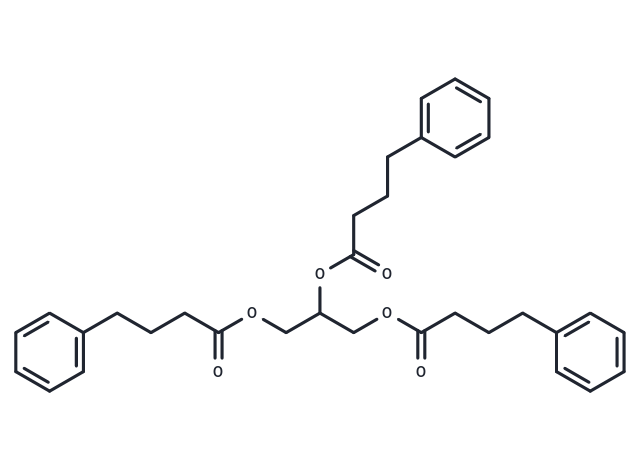Shopping Cart
Remove All Your shopping cart is currently empty
Your shopping cart is currently empty
Glycerol phenylbutyrate (HPN-100) (GPB) is a new generation ammonia scavenger drug and it also is a sigma-2 (σ2) receptor ligand (pKi: 8.02).

| Pack Size | Price | USA Warehouse | Global Warehouse | Quantity |
|---|---|---|---|---|
| 10 mg | $39 | In Stock | In Stock | |
| 25 mg | $59 | In Stock | In Stock | |
| 50 mg | $80 | In Stock | In Stock | |
| 100 mg | $147 | In Stock | In Stock | |
| 200 mg | $218 | - | In Stock | |
| 1 mL x 10 mM (in DMSO) | $43 | In Stock | In Stock |
| Description | Glycerol phenylbutyrate (HPN-100) (GPB) is a new generation ammonia scavenger drug and it also is a sigma-2 (σ2) receptor ligand (pKi: 8.02). |
| Targets&IC50 | σ2 receptor:pKi: 8.02 |
| In vivo | Glycerol phenylbutyrate may have therapeutic potential in additional conditions such as chronic hepatic encephalopathy or other inherited metabolic disorders. Glycerol phenylbutyrate also has the potential for the treatment of hyperammonemia. [1][2]. |
| Synonyms | HPN-100 |
| Molecular Weight | 530.65 |
| Formula | C33H38O6 |
| Cas No. | 611168-24-2 |
| Smiles | O=C(CCCc1ccccc1)OCC(COC(=O)CCCc1ccccc1)OC(=O)CCCc1ccccc1 |
| Relative Density. | 1.131 g/cm3 (Predicted) |
| Color | Transparent |
| Appearance | Liquid |
| Storage | Powder: -20°C for 3 years | In solvent: -80°C for 1 year | Shipping with blue ice/Shipping at ambient temperature. | |||||||||||||||||||||||||||||||||||
| Solubility Information | DMSO: 150 mg/mL (282.67 mM), Sonication is recommended. | |||||||||||||||||||||||||||||||||||
| In Vivo Formulation | 10% DMSO+40% PEG300+5% Tween 80+45% Saline: 4 mg/mL (7.54 mM), Sonication is recommended. Please add the solvents sequentially, clarifying the solution as much as possible before adding the next one. Dissolve by heating and/or sonication if necessary. Working solution is recommended to be prepared and used immediately. The formulation provided above is for reference purposes only. In vivo formulations may vary and should be modified based on specific experimental conditions. | |||||||||||||||||||||||||||||||||||
Solution Preparation Table | ||||||||||||||||||||||||||||||||||||
DMSO
| ||||||||||||||||||||||||||||||||||||
| Size | Quantity | Unit Price | Amount | Operation |
|---|

Copyright © 2015-2026 TargetMol Chemicals Inc. All Rights Reserved.